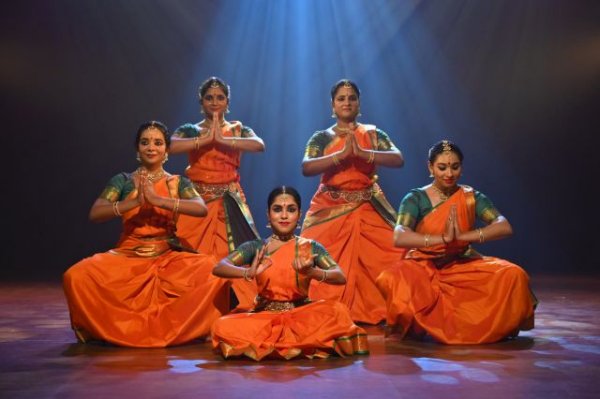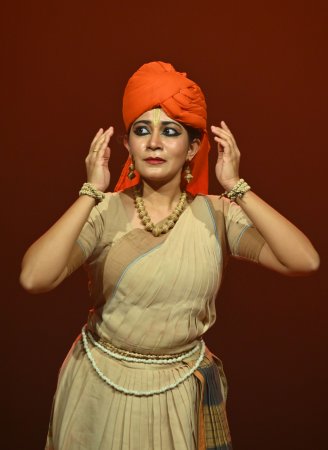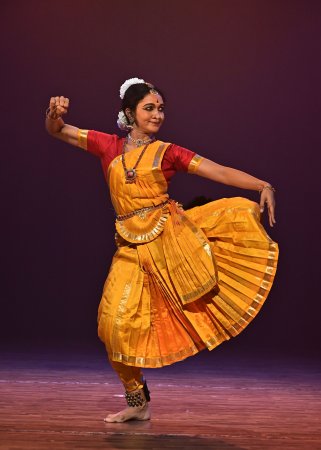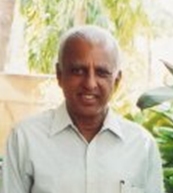
|   |

|   |
Dancing devotion: A Bharatanatyam tribute to Dasa Sahitya- Satish Surie-mail: satishism@yahoo.co.in Photos: Temple Sounds July 2, 2025 Youth in Dance 2025, presented on the 15th of June at Medai, Bangalore, and curated by Guru Padma Murali and Janani Murali, offered a meditative and aesthetically rich celebration of Dasa Sahitya, recontextualizing the spiritual poetry of Karnataka's Haridasas through Bharatanatyam. Each composition was curated and choreographed with thoughtful restraint and spiritual sensitivity, creating a performance arc that was both contemplative and cathartic.  Padmalaya Dance Ensemble The evening opened with "Madhvanama", choreographed by Janani Murali and performed by the Padmalaya Dance Ensemble - Aninditha Ashok, Shreenithy CV, Shreya Viseaswar, Kruthika, and Vishaka - in a seamless synthesis of movement and metaphysics. The work, drawing from Sripadaraya's poetic vision, traced Vayu's incarnations with a choreographic intelligence that balanced esoteric symbolism with dynamic storytelling. The ensemble moved as one body yet differentiated each avatar's essence: Hanuman's playful yet profound wisdom (the backward walk toward Surya lingering as a striking visual metaphor), Bhima's explosive physicality in the Bakasura episode, and finally, Madhvacharya's scholarly gravity. Particularly compelling was the use of spatial patterns to mirror the Kurma (tortoise) imagery - dancers' interlinked formations evoking the cosmic balance between Vishnu's avatar and Sesha's gravitational pull. Janani Murali's nattuvangam provided rhythmic scaffolding, while the live ensemble - Rajeev's resonant vocals, Srihari Rangaswamy's percussive textures on mridangam, and Narasimhamurthy's flute phrases - heightened the work's devotional core. If there was a critique, it lay in the occasional tension between abstraction and narrative clarity; some transitions demanded prior knowledge of the philosophical subtext. Yet, this minor opacity only deepened the work's mystique, inviting the audience to lean in rather than passively receive. The dancers' collective precision and emotional investment affirmed Padmalaya's reputation for nurturing artistes who combine technical rigour with interpretive depth. Their portrayal of Vayu's tripartite journey wasn't merely performative but transformative - a fitting prelude to an evening dedicated to the Dasas' vision of the divine as ever-present, if one knows how to look.  Kruthika Thyagarajan Kruthika Thyagarajan's "Bandu Hoda Haadi" unfolded as a meditation on separation - not as absence, but as the quiet alchemy that transforms longing into devotion. Drawing from Purandara Dasa's poetry, every glance and gesture seemed to emerge from deep introspection. Her abhinaya was remarkable for what it withheld as much as what it revealed - a flicker of the eyes tracing an invisible departure, a slow turn of the wrist as if releasing an unseen hand. The choreography avoided theatrical lament, instead tracing the sublime paradox of bhakti: that what appears as loss is often the soul's homecoming. Trained under Guru Shakuntala Prabhat, Kruthika's movement vocabulary carried a distilled elegance - her transitions between stillness and motion were seamless. The musical ensemble functioned as an extension of her emotional landscape. Harshitha Vidya's vocals did not merely accompany but conversed with the dance, her voice bending phrases with a vulnerability that mirrored sahitya's unspoken ache. Sai Vamshi's percussion was a masterclass in restraint - mridangam strokes like heartbeats pausing mid-rhythm, kanjira whispers dissolving into silence as if the sound itself were hesitant to intrude on grief's sanctity. Rakesh Dath's flute wove through this space like a breath of remembrance, its melodies curling around Kruthika's movements in tender counterpoint. Unlike conventional narratives that culminate in divine union, "Bandu Hoda Haadi" dwelled in the holy uncertainty of the in-between, where every step away from the earthly companion becomes a step toward the divine. Kruthika's artistry lay in making this liminal space feel not like purgatory, but a threshold of revelation. By the final mudra, the stage seemed to hum with the unspoken truth of the Dasas' wisdom: that the deepest bonds are those that lead us, however painfully, beyond themselves.  Sathvikaa Shankar Sathvikaa Shankar's 'Darshana Vismayi' was the evening's climactic offering, engaging with the theme of divine encounter as an act of grace and astonishment. The piece referenced three revered Haridasas - Kanakadasa, Raghavendra Swamy, and Purandara Dasa - and their moments of spiritual awakening. Sathvikaa, a disciple of Guru Anitha Guha, brought dramatic clarity to each persona, distinguishing them through distinct physicalities and emotional tones. Her portrayal of Kanakadasa witnessing the deity through a crevice - the "Kanakana Kindi" - was moving not for its narrative accuracy but for the sense of personal astonishment she embodied. Likewise, the serene dignity with which she conveyed Raghavendra's compassionate interventions spoke of an inner poise cultivated through both practice and empathy. The music for this piece, adapted and directed by Dr. Sridhar Vasudevan, was elegant in its minimalism. The melodic framework was unhurried, allowing ample space for abhinaya to unfold. The vocalist's nuanced approach provided tonal shading to each episode, while the percussion offered a gentle undercurrent that never disturbed the piece's meditative tempo. The flute was employed sparingly, often entering as a response to key emotional moments, providing a sonic glow that lingered long after the scene had passed. Across all the pieces, what stood out was the curatorial decision to foreground Dasa Sahitya as living literature - embodied through dance, voiced through music, and felt through silence. The saint-poets were not treated as relics of a devotional past but as guides to interiority, their verses offering pathways to explore contemporary spiritual longing through classical idiom. The performance eschewed ornate spectacle in favour of emotional authenticity and interpretive depth. The lighting was subtle and effective, providing spatial and emotional cues without intruding on the performance's intimacy. The musical ensembles were not merely supportive but synergistic, working hand-in-hand with the dancers to co-create meaning. Each composition's melodic, rhythmic, and lyrical dimensions were shaped to reflect the inner architecture of the dance, resulting in a seamless integration of sound and movement. This collaboration between dancer and musician, choreographer and composer, resulted in a quiet alchemy where the devotional and the artistic became indistinguishable.  Bangalore based Satish Suri is an avid dance rasika besides being a life member of the Music and Arts Society. |